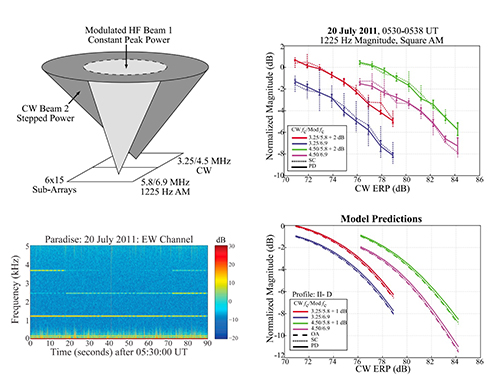ELF/VLF Wave Generation
ELF/VLF (~3 Hz - 30 kHz) waves have a number of different practical uses. Waves in these frequency bands can propagate 1000's of kilometers around the globe with little attenuation, making them ideally suited for global communications and large-scale ionospheric remote sensing. They are useful for geophysical prospecting and for global-scale lightning geo-locating. They also penetrate deeply into seawater compared to waves at higher frequencies, making them suitable for communications with submerged vehicles. These waves can also propagate into space, where they interact with radiation belt particles.
Conventional methods for generating ELF/VLF waves are typically expensive and inefficient, and they require a large land area. For instance, a number of VLF transmitters make use of surrounding mountain ranges from which to hang their active elements. Our research group investigates unconventional means to generate ELF/VLF waves. One such method is to modulate naturally occuring ionospheric currents using a high-power HF radio transmitter, such as the one operated by HAARP. ELF/VLF wave generation has a rich history dating back to the 1970's. It has been well established that the nonlinear absorption of the HF radio waves modifies the electron temperature, and thereby the conductivity, of the D-region and possibly the lower E-region of the ionosphere. When the heating stops, the D-region ionosphere rapidly recovers to its ambient state with a characteristic timescale on the order of a few hundred microseconds. In the presence of the auroral electrojet current system, the modulated ionospheric conductivity produces a time-varying current that radiates at the modulation frequency and its harmonics.
Our research group focuses on quantifying the nonlinear processes responsible for ELF/VLF wave generation by measuring the amplitude and phase of ELF/VLF waves generated above HAARP using a network of ground-based ELF/VLF receivers. We use our measurements to validate physical models of ionospheric processes. We also aim to creatively improve our transmission formats in order to increase the efficiency of ELF/VLF wave generation.

Upper Left: A cartoon diagram of dual-beam heating scheme. Lower Left: Spectrogram format ELF/VLF observations at Paradise showing the 1225 Hz tones and harmonics. Upper Right: Observed ELF/VLF magnitudes as a function of CW power at Sinona Creek (SC) and Paradise (PD). Lower Right: Model predictions for Sinona Creek (SC) and Paradise(PD).
Figure 1 above shows the results from a recent HAARP experiment focused on dual-beam heating of the ionosphere [Agrawal and Moore, 2012]. During this experiment, HAARP broadcast two HF beams: one beam modulated the ionospheric conductivity at ELF frequencies while the other beam broadcast a CW wave at a variety of power levels. Due to the nonlinear nature of HF ionospheric heating, the CW heating modified the efficiency of ELF wave generation. We compared our experimental observations to the predictions of a theoretical model, demonstrating excellent agreement.

Left: A cartoon diagram of the HF-ELF propagation paths. Right: TOA analyisis showing the received ELF/VLF amplitude as a function of time at Sinona Creek and Milepost 71.
Time-of-Arrival (TOA) experiments use a chirped-frequency modulation format as a means to measure the propagation delay between the transmitter (HAARP) and the receiver, as demonstrated by Fujimaru and Moore [2011]. The propagation delay is the sum of the time it takes for the HF transmission to reach the ionosphere and the time it takes for the ELF/VLF waves to reach the receiver. Assuming a simple geometry and speed-of-light propagation, we are able to approximate the ELF/VLF source height for a variety of different types of HF transmissions. We are also able to distinguish between different multipath components of the ELF/VLF waves: those that arrive via a line-of-sight path and those that are ionospherically reflected.

